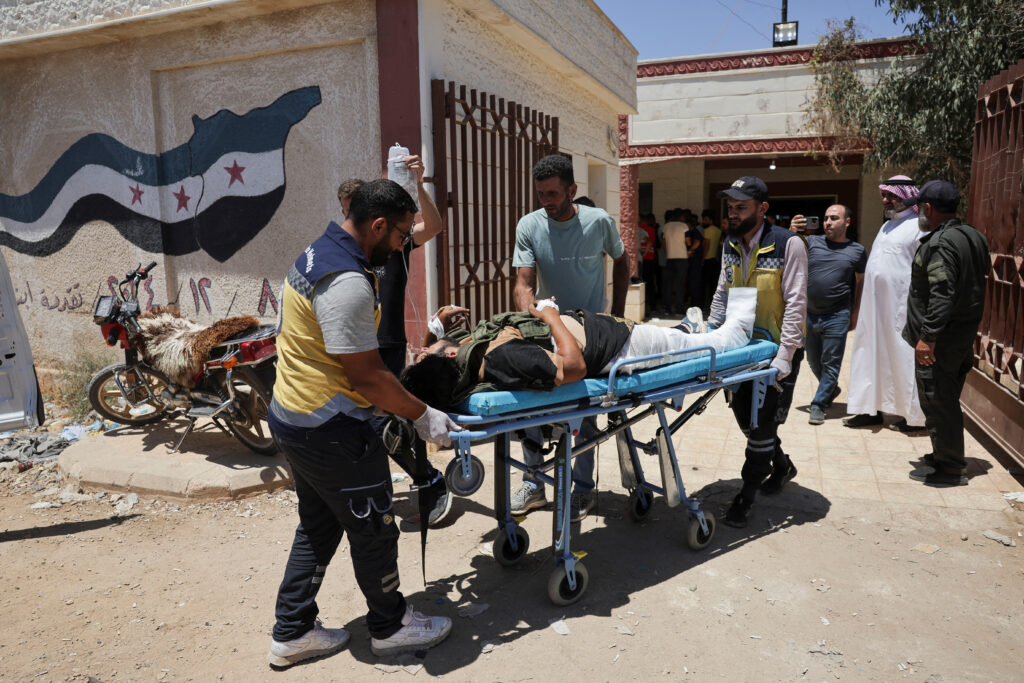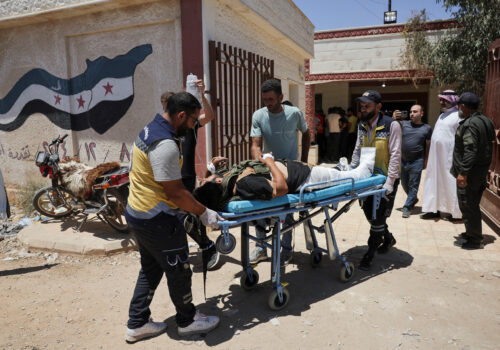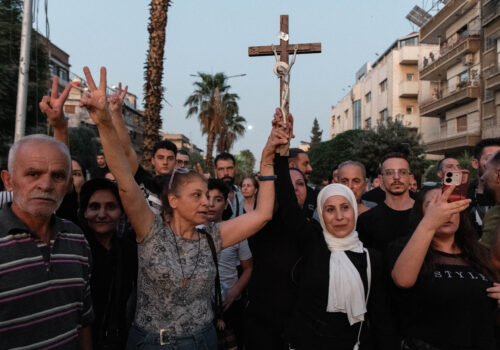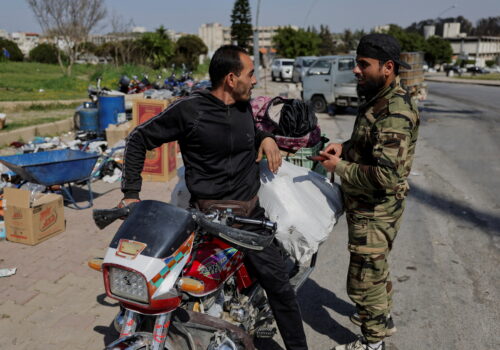In a sectarian Syria, the winners should refrain from taking all
When the sweeping offensive of rebels led by Hay’at Tahrir al-Sham (HTS), a Sunni Islamist group, ousted Bashar al-Assad in December 2024, the majority of Syrians celebrated the end of a fifty-four-year dictatorship. Yet, a fault line quickly emerged between Syrians referring to the “the liberation of Syria” and those to “Assad’s fall”, reflecting diverging support for the new leadership.
Seven months later, Syrians who are still elated with “the liberation of Syria” have become very assertive in the public space, strengthened as being part of the dominant group in the Syrian society, largely aligned with the new power in place and eager to benefit from it. In addition to HTS’s support base in the Idlib governate’s conservative society, these Syrians belong mostly to the moderate to conservative Sunni community, especially members of the lower and middle classes. These groups made up the backbone of the civilian and armed opposition to the Assad regime during the 2011 revolution and ensuing war, and they consider themselves to be the winners in the new Syria. This may be reinforced by the current regional dynamic characterized with the rise of the strong Sunni leaders, like Saudi Arbia’s Crown Prince Mohamed bin Salman and Turkish President Recep Tayyip Erdogan, coupled with the collapse of what used to be the Shia crescent led by Iran.
While a “winner takes all” approach is common to many post-conflict contexts, it is especially dangerous in the fragmented Syrian society, where Assad instrumentalized religious identities to fuel the war. An emboldened group may trigger tensions with other communities, leading to a new conflict. In order to avoid the complete supremacy of Sunnis supportive of HTS’s leadership in Syria’s new order and to foster social cohesion, it is crucial to implement a comprehensive reconciliation process and to adopt power-sharing mechanisms guaranteeing religious, ethnic, gender and political inclusiveness.
Reversal after decades of marginalization
Throughout the country, Sunni Syrians who the Assad regime had for years oppressed have expressed pride in belonging to the majority that is back in power. In the absence of reliable statistics, the European Union Agency for Asylum estimates that Sunnis accounted for around 65 to 75 percent of the pre-war population. From 1970 until last December, the country was ruled by Hafez al-Assad and then his son Bashar, who belong to the minority Alawite sect, an offshoot of Shia Islam representing between 10 and 13 percent of Syria’s pre-war population.
But Syrians cannot be reduced to a community affiliation.
SIGN UP FOR THIS WEEK IN THE MIDEAST NEWSLETTER
Many purely define themselves as their country’s citizens, rejecting religious and ethnic differentiation, as one of the slogans of the revolution, “the Syrians are one”, illustrated. Yet, over the past decades, the Assad regime instrumentalized sects to consolidate its power, concentrated in the hands of close Alawite and a loyalist circle, with Alawites dominating the army, the security apparatus, and the administration. The Assad regime also relied on part of the Sunni elite, especially businessmen, as well as some Sunni tribes, and Christian religious leaders, who all benefited from their loyalty to the regime.
Today, my understanding based on my reporting on the ground is that those who consider themselves as the post-Assad winners now have a president they can relate to—even for those who overcame initial suspicion about his jihadist past—and they don’t feel marginalized anymore. Overall, Sunnis feel more optimistic about the future of the country and more positive about the changes it is going through than other communities, according to a public-opinion poll conducted on behalf of The Economist in March.
The Assad regime’s marginalization and oppression of the conservative Sunni lower and middle class was a driving force in the March 2011 revolution, which erupted amid a lack of access to economic opportunities or jobs for the group, and a significant migration from rural areas to impoverished suburbs amid financial and agricultural hardship. Throughout the war, the regime grew increasingly sectarian, relying on Alawite militias, Hezbollah and Iran. The regime disproportionately targeted and persecuted the Sunni community that rose against it, including sieges and constant bombings. Therefore, the seizure of power by HTS amounts to a revenge over the defeated regime for those who suffered years of oppression, with many who I have spoken with believing that they deserve rewards in the new Syria. The new government has delegated almost all important official positions —including all positions in the security sector—to members of the Sunni community, especially members of the Idlib network.
Another indicator of the Sunni winners’ assertiveness is the extent to which their conservative traditions are becoming dominant in the public sphere. For example, in early June, a decision of the Ministry of Tourism required women to wear full-body covering swimwear on public beaches and swimming pools. While this decision triggered a public outcry, prompting the Minister to backtrack, it sent a clear signal regarding clothing and behavior in the public space.
Risk of destabilization of the fragile transition
The ascendency of the Sunnis who consider themselves to be the winners presents a danger in a country where the former regime instrumentilized sectarian identities to fuel the conflict, and it opens the way for revenge on those who benefitted from the oppressive Assad regime. The attack against Christians worshippers in a Damascus church in late June demonstrates that enemies of the transition consider the sectarian issue as the weak point of the authorities. Although the authorities have consistently repeated messages of unity and cohesion, members of various religious and ethnic groups have felt unsafe and some have felt left aside.
Tens of thousands of members of the former regime’s army, who used to employ a significant number of Alawites, have been laid off shortly after Assad’s fall. Recruits for the new army have so far come almost exclusively from the Sunni community raising concerns regarding the possibility of a Sunni-only army. Alawites have not attempted to join recruitment for the new army as the mistrust is too deep on both sides, with reports of religious speeches in army recruitment centers that would antagonize non-Sunni individuals.
Based on conversations through my reporting in Homs city, some Sunni residents feel emboldened enough to say that Alawites are not welcome and should leave. With kidnappings and killings routinely targeting members of their community, some Alawites have fled their homes and some have gone abroad. Alawites have deserted a number of previously mixed villages between Homs and Hama cities.
Although it is unclear how permanent this move is, the perspective of a redrawing of the demographic map of Syria is deeply concerning, as the former regime altered the demographic makeup of various areas through expropriation during the war.
The authorities mainly view sectarian tensions through a security lense. Damascus frames the massacre that erupted early March in coastal areas, for example, as fighting back against a coup attempt from remnants of the Assad regime. Although that bout of violence started with attacks from Assad loyalists, fighters aligned with the government subsequently killed several hundreds of Alawite civilians. This violent episode raised the alarm on the risk of further deterioration, as killing and kidnappings of Alawites continue, according to my local sources.
Regional context
What happened in neighboring Iraq provides a textbook example of the chaos that a “winner takes all” approach may trigger. In 2003, the US military intervention overthrew Saddam Hussein, putting an end to a Sunni-minority rule. Based on a controversial power-sharing agreement, a Shia-majority government took over and Shia groups have dominated Iraq’s politics, security forces and administration since. The awakening of the Shia identity, coupled with the Sunni marginalization, led to a sectarianization of Iraq after 2003, which was exacerbated by the flaws of the power sharing mechanism. It turned into a civil war in 2006-2008, from which the Islamic State of Iraq and al-Sham emerged. The Iraqi experience illustrates how the domination of one community destabilizes the post-conflict phase and triggers a backlash. Syrians are mindful of the Iraqi experience and want to avoid a fate similar to their neighbor’s.
The internal Syrian trend of Sunni assertiveness could fit into a parallel regional dynamic, potentially mutually reinforcing each other. These past months, portraits of the late Iraqi leader have emerged on banners at demonstrations and in shops next to famous soccer players and singers. It illustrates a sense of renewed pride that some members of the Sunni community feel. This coincides with the rise of the influence of Sunni strongmen like Saudi Arbia’s Crown Prince Mohamed bin Salman and Turkish President Recep Tayyip Erdogan, who have commanded an expanding regional influence over the last decade. Additionally, Israel’s multi-front war since the October 7, 2023 Hamas attacks has also significantly weakened Iran and its proxies, helping to facilitate a crumbling of the Shia crescent. This context has opened space for powerful leaders who intend to shape the direction of the region and establish a Sunni leadership.
Reconciliation and power sharing
To guarantee a peaceful transition, it is crucial to resist a “winner takes all” approach and to ensure inclusion of all ethnic and religious groups, women, and political views—including liberal Sunnis—in the new Syria.
At the political level, it is crucial that all groups are able to meaningfully participate in decision-making and to contribute to shaping the reconstruction of the country. Even though the interim government that was appointed in late March includes an Alawite, a Christian woman, a Kurd, and a Druze among the ministers, key executive powers, among ministers and in the administration, remain in the hands of HTS affiliates. HTS and its affiliates’s domination in Syria’s new political life carries a risk of marginalization of other stakeholders.
Instead, a geographic approach, guaranteeing the representation of each district of every governorate, could help to facilitate the necessary inclusion of all Syria’s communities, including ones concentrated in specific areas. The discussions these past months with Kurdish and Druze representatives about the integration of their areas under a centralized system controlled by Damascus illustrates the difficulty to find a governance model that balances power sharing, inclusion of all communities and unity of the country. While political inclusion is key, it is equally important that all Syrians are included in the reconstruction, benefit from economic opportunities and are able to join institutions.

The clashes between government security forces, Sunni Bedouin fighters, and militants from the Druze sect that erupted mid-July in the southern province of Swaida are the latest exemple of how the difficulty of the interim government to ensure the safety of all communities and their political inclusion in the new Syria undermines the transition. The fact that part of the Druze community questions Damascus’ authority and that Druze factions have not joined the national security forces has caused instability.
To further defend against the risk of sectarian conflict— an extensive transitional justice and reconciliation process is the only way to prevent the “winners” from seeking revenge, and to restore a degree of social cohesion. For the tens of thousands of Syrians victims to be able to have a sense of closure, harms that they suffered from should be acknowledged and perpetrators should be identified. In addition, a comprehensive transitional justice process is essential to bring redress and guarantee accountability for crimes commited during the Syrian war. Such a process should go beyond criminal justice and target crimes committed by all sides through reconciliation committees and initiatives. This may also include truth and reconciliation initiatives, as other countries have resorted to at the end of war. Ultimately, members of the Alawite community who did not commit crimes should not be associated with the former Assad regime’s atrocities.
A fact-finding committee’s recent report on the massacres carried out in coastal areas in March will present a test regarding accountability. The report identified 298 suspects, whose names have been referred to the public prosecutor. Transparent prosecutions are necessary to show that individuals affiliated with the winners are not above the law.
A genuine transitional justice and reconciliation process addressing the crimes committed during the war by all parties will quell the desire of revenge and will appease sectarian tensions. In addition, meaningful inclusion of all the components of the Syrian society will mitigate grievances leading to a backlash against the new authorities, and will rather increase the chances of the transition’s success. Syrians now have the opportunity to put an end to years of sectarianism and build a shared identity, paving the way to durable peace.
Marie Forestier is a nonresident fellow for the Syria Project in the Atlantic Council’s Middle East programs. She is also currently a consultant for the European Institute of Peace and the co-director of the Syria Strategy Project.
Further reading
Tue, Jul 22, 2025
Why the violence in my hometown, Swaida, goes beyond ‘rivalry.’
MENASource By
US officials described the events as “a rivalry” between Syria's Druze and Bedouins. But this framing strips the crisis of its historical and political context.
Thu, Jun 26, 2025
Dispatch from Damascus: Church attack shows transition’s fragility
MENASource By Ibrahim Al-Assil
The bombing at Mar Elias Church is more than an isolated tragedy. It is a signal that Syria’s transition remains vulnerable to sabotage.
Tue, Jun 10, 2025
Why DDR programs are the missing link to Syrian stability
MENASource By
With the end of Western sanctions, Syria faces a rare opportunity to address the imbalances of the post-conflict period.
Image: A gunman stands as Syrian security forces check vehicles entering Druze town of Jaramana, following deadly clashes sparked by a purported recording of a Druze man cursing the Prophet Mohammad which angered Sunni gunmen, as rescuers and security sources say, in southeast of Damascus, Syria April 29, 2025. REUTERS/Yamam Al Shaar



